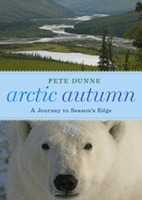One of the most poignant as well as multifaceted metaphors in the literature of the English language is that of Autumn. Often employed as an image of the wisdom that can only come from maturity, “No man can taste the fruits of autumn while he is delighting his scent with the flowers of spring” (Samuel Johnson); sometimes reflective of the imminent decline toward old age, “Autumn wins you best by this its mute appeal to sympathy for its decay” (Robert Browning) – Autumn is almost always a symbol of transition.
Naturalists of a poetic disposition know this perhaps better than anyone else. They see the transitions inherent in the world; they mark well the time as one season passes into another. Not unexpectedly, they often also mark the changes they observe in themselves. Which is why it is so very appropriate that Pete Dunne, one of America’s most poetically disposed naturalists, has taken Autumn as theme of his third book in his series of seasonal biome portraits. Perhaps more so than any of his previous works, it is a book he could not have written ten years ago nor would he have been able to do so ten years from now. Near the top of the world, he and his subject met face to face at the right time in both their respective lives and Arctic Autumn was the result.
Just as the Autumn of one’s life begins much sooner than it might have been expected, so too begins Arctic Autumn. As Dunne so well repeatedly depicts, our modern interpretations of time are not appropriately applied to the Arctic. Autumn does not begin with the turning of the leaves; it begins – biologically as well as metaphorically – at the first second following the Summer Solstice. Thus it is only appropriate that this is when we meet Pete and his wife, the renowned photographer Linda Dunne, as they prepare to record this moment of transition. It will not be the last transition Dunne discovers.
From business and economic cycles to human and animal population shifts, not forgetting of course climactic changes and the effects they bring as well, Arctic Autumn is a study in transitions. As one season slides into another, so changes the land and the wildlife that calls it home – either for a few weeks or all throughout the year. So too change the lives of those who seek these wild creatures, professionally, recreationally, or as an essential element of their very own survival.
Through Dunne’s eyes, the Autumn of the arctic is not limited to a quarter of a calendar year, it encompasses much of what is happening in the arctic today. Just as it’s plants and wildlife are, for most of their existence, widely scattered and cryptic to the point of being generally difficult to see, so the biome itself is, being separated from the majority of us in the more populated areas of the globe, similarly obscure and its changes difficult to perceive.
Nevertheless, Dunne challenges the reader to do so. Not through an unceasing torrent of data or eco-political posturing, but by, as E. M. Forster so eloquently proposed, “only connecting.” Connecting across geographic boundaries and political lines; connecting what we do with the results it causes. It is a wisdom as seemingly plain as a water-smoothed rock plucked from beside an arctic stream – yet the longer one contemplates it, the more perfectly formed one perceives it to be.
 Book Title: Arctic Autumn; A Journey to Season’s Edge
Book Title: Arctic Autumn; A Journey to Season’s Edge
Author: Pete Dunne
Publisher: Houghton Mifflin Harcourt
Imprint: Houghton Mifflin Harcourt
Format: Clothbound
ISBN-13/EAN: 9780618822218
Published: September 20, 2011
This review was originally published in Bird Watcher’s Digest.
In accordance with Federal Trade Commission 16 CFR Part 255, it is disclosed that the copy of the book read in order to produce this review was provided gratis to the reviewer by the publisher.

May 2, 2012 @ 11:23
Excellent review of one of an excellent series of books. Thanks.
May 2, 2012 @ 12:49
Thanks! I really like what Pete is doing with this series. I can only hope that the final one will “wrap it all up” into a nice and tidy package.
May 5, 2012 @ 12:34
I’ve got some bad new for you, John. The final book isn’t going to be published. At least, not by Houghton. Sadly, the series apparently hasn’t done as well as they had hoped. It could still end up being published by someone else, and I really, really hope that it is.
By the way, it was going to be set in the Everglades area.
May 8, 2012 @ 16:16
Truly unfortunate news indeed. Thanks for the tip Grant.
Review Roundup: April, 2012
May 5, 2012 @ 12:36
[…] The Well-read Naturalist […]